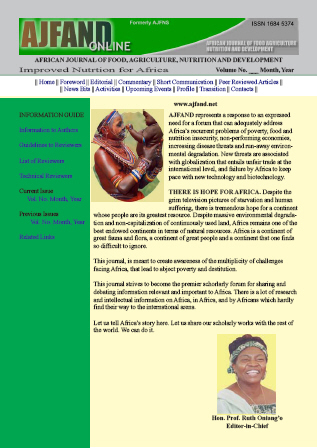
|
African Journal of Food, Agriculture, Nutrition and Development
Rural Outreach Program
ISSN: 1684-5358
EISSN: 1684-5358
Vol. 18, No. 2, 2018, pp. 13541-13557
|
 Bioline Code: nd18048
Bioline Code: nd18048
Full paper language: English
Document type: Review Article
Document available free of charge
|
|
|
African Journal of Food, Agriculture, Nutrition and Development, Vol. 18, No. 2, 2018, pp. 13541-13557
| en |
COMPLEMENTARY FEEDING PRACTICES AMONG CHILDREN UNDER TWO YEARS OLD IN WEST AFRICA: A REVIEW
Mitchodigni, IM; Amoussa Hounkpatin, W; Ntandou-Bouzitou, G; Termote, C; Bodjrenou, FSU; Mutanen, M & Hounhouigan, DJ
Abstract
The burden of child malnutrition is still high in West African countries with 19.2 million
stunted children and increases rapidly during the weaning period. This has been
attributed to inappropriate complementary feeding practices. To our knowledge, few
studies have tried to review the state of complementary feeding in the sub-region. This
review aimed to provide an overview of current complementary feeding practices in West
Africa in order to identify issues that should be targeted for ensuring optimal infant and
young child nutrition. Articles and reports published from 2006 to 2016 were selected
and reviewed. All documents were accessed through PubMed, Google scholar, and
FreeFullPDF databases. Relevant and current documents focused on infant and young
child (IYC) feeding from World Health Organization (WHO) and the United Nations
Children’s Fund (UNICEF) were identified by using electronic searches via the Google
platform. Complementary feeding practices are suboptimal in West Africa compared to
the Northern Africa. Porridges and family dishes are the two main categories of
complementary foods given to children and there are nutritionally inadequate. Enriched
flours have been developed by using local diversity of food resources and improved food
process like dehulling, fermentation, germination, malting, but their use remains low.
Socio-economic, cultural and geographical factors were the determinants influencing
IYC feeding practices at mother and household levels. Besides food availability, social,
cultural, economic and geographic determinants were interrelated in a complex way to
affect child feeding practices. This paper contributes to a much-needed evidence-based
focus on the state of complementary feeding practices. As a key component to child
survival, the improvement of complementary feeding has been shown to be the most
effective in enhancing child growth and reducing stunting. Stakeholders such as policy
and decision-makers, development partners, the private sector, and Non-Governmental
Organizations should develop strategies for making enriched flours and nutritionally
dense foods more accessible and affordable. Nutritional interventions should emphasize
the promotion of adequate complementary feeding practices including feeding
frequency, quality and quantity of diet and food safety in order to reduce malnutrition.
Ongoing national plans and strategies for optimal IYC feeding should be encouraged to
reduce child malnutrition.
Keywords
complementary feeding; practices; determinants; nutrition plans; West Africa
|
| |
© Copyright 2018 - African Journal of Food, Agriculture, Nutrition and Development
Alternative site location: http://www.ajfand.net/
|
|
